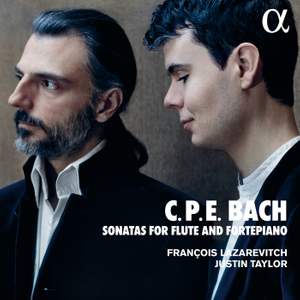C. P. E. Bach: Sonatas for Flute and Fortepiano
François Lazarevitch (flute), Justin Taylor (harpsichord)
individually and together, Lazarevitch and Taylor know their way around this music, and these performances are skillful and expressive, and stylistically astute, even if they are not stylistically... — More…
-
Gramophone MagazineCritics' Choice 2022
CD
$16.50Downloads
What are FLAC and MP3?Contents
Bach, C P E: Trio Sonata for Flute, Violin and Continuo in D minor, H569 (Wq145)
- François Lazarevitch, Justin Taylor
I. Allegretto
II. Largo
III. Allegro
Bach, C P E: Flute Sonata in D major, Wq. 83 (H505)
- François Lazarevitch, Justin Taylor
I. Allegro un poco
II. Largo
III. Allegro
Bach, C P E: Sonata in A minor, Wq. 132 (H562)
- François Lazarevitch
I. Poco adagio
II. Allegro
III. Allegro
Bach, C P E: Trio Sonata in C major, Wq. 149 (H573)
- François Lazarevitch, Justin Taylor
I. Allegro di molto
II. Andante
III. Allegretto
Bach, C P E: Fantasia in F-Sharp Minor, Wq. 67
- Justin Taylor
I. Adagio - Allegretto
II. Largo - Adagio - Largo
III. Adagio - Allegretto - Adagio - Allegretto - Largo
Bach, C P E: Trio in B minor for flute, violin and basso continuo, Wq 143
- François Lazarevitch, Justin Taylor
I. Allegro
II. Adagio
III. Presto






